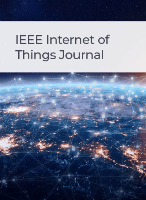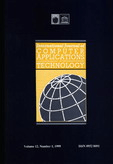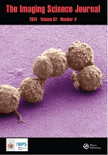
International Arab Journal of Information Technology
Scope & Guideline
Empowering Research, Shaping the Future of IT
Introduction
Aims and Scopes
- Artificial Intelligence and Machine Learning:
The journal consistently emphasizes research in artificial intelligence (AI) and machine learning (ML), showcasing applications ranging from healthcare diagnostics to security systems. The methodologies often involve deep learning, ensemble learning, and hybrid algorithms. - Data Security and Privacy:
A significant focus is placed on data security, exploring encryption techniques, intrusion detection systems, and secure communication protocols, particularly in cloud and IoT environments. - Natural Language Processing (NLP):
The journal includes numerous studies on NLP, particularly concerning Arabic language processing, sentiment analysis, and text classification, reflecting the regional linguistic context. - Image and Signal Processing:
Research on image processing techniques, including facial recognition, medical imaging, and video surveillance, is prevalent, highlighting advancements in computer vision and pattern recognition. - Optimization Algorithms:
The journal features numerous papers on optimization algorithms, particularly in the context of resource allocation, scheduling in cloud computing, and network management, reflecting a strong focus on improving system performance. - Big Data and Data Analytics:
There is a recurring theme of big data analytics, with studies addressing data mining, predictive modeling, and the application of statistical techniques to extract meaningful insights from large datasets. - IoT and Smart Systems:
Research on Internet of Things (IoT) applications is prominent, focusing on smart healthcare, environmental monitoring, and security in IoT networks, showcasing the journal's commitment to modern technological solutions.
Trending and Emerging
- Advanced Machine Learning Techniques:
There is a growing emphasis on advanced machine learning techniques, including deep learning and hybrid models, which are increasingly applied to diverse domains such as healthcare, finance, and security. - Integration of AI in Everyday Applications:
Research is trending towards the integration of AI in everyday applications, particularly in education, healthcare, and smart city initiatives, reflecting a broader societal impact of technology. - Blockchain and Decentralized Systems:
An emerging focus on blockchain technology and decentralized systems is evident, with applications in secure data sharing, electronic voting, and healthcare systems, showcasing the need for transparency and security. - Augmented and Virtual Reality Applications:
The journal is seeing an increase in studies related to augmented and virtual reality, particularly in educational and training contexts, indicating a trend towards immersive learning experiences. - Sustainability and Green Technologies:
Research addressing sustainability, particularly in relation to IoT and smart technologies, is increasingly prevalent, reflecting a global trend towards environmentally conscious technological development.
Declining or Waning
- Traditional Software Engineering Methods:
Research focused on conventional software development methodologies appears to be decreasing, as the journal shifts towards innovative approaches like agile and DevOps practices. - Basic Algorithmic Studies:
The focus on fundamental algorithmic studies without significant application has waned, with more emphasis on applied research that demonstrates real-world impact and technological advancements. - Static Data Processing Techniques:
There is a noticeable decline in papers dedicated solely to static data processing techniques, as the field moves towards dynamic, real-time data analysis and machine learning applications. - Non-Contextualized Research:
Papers that lack regional context or applicability to the Arab world are becoming less frequent, indicating a trend towards more localized research that addresses specific challenges in the region. - Legacy Systems and Technologies:
Research dealing with outdated technologies or legacy systems is less common, as the journal increasingly prioritizes discussions surrounding emerging technologies and innovative solutions.
Similar Journals

IEEE Internet of Things Journal
Shaping Tomorrow's Smart EcosystemsWelcome to the IEEE Internet of Things Journal, a leading publication in the field of connected systems and smart technologies. Published by the IEEE - Institute of Electrical and Electronics Engineers Inc, this journal is dedicated to disseminating cutting-edge research and innovative developments in the Internet of Things (IoT) domain. With an impressive impact factor and recognized as a Q1 journal across multiple categories such as Computer Networks and Communications, Information Systems, and Signal Processing, the IEEE Internet of Things Journal serves as an essential resource for researchers, industry professionals, and students looking to advance their knowledge and contribute to this rapidly evolving field. Since its inception in 2014, the journal has steadily risen to prominence, ranking impressively in Scopus metrics with top positions in key categories, ensuring high visibility and credibility in the academic community. We invite you to explore the rich array of articles and access options available to support your research endeavors in one of the most transformative areas of technology today.

Journal of Information Assurance and Security
Pioneering Research in Information Integrity.Journal of Information Assurance and Security, an esteemed publication by DYNAMIC PUBLISHERS, INC, serves as a pivotal platform for the dissemination of innovative research and insights in the field of information security and assurance. With its ISSN 1554-1010 and E-ISSN 1554-1029, this journal addresses critical vulnerabilities, emerging technologies, and methodologies that fortify data integrity and uphold privacy in our increasingly digital world. Although specific metrics such as the HIndex and Scopus ranks are currently unavailable, the journal is recognized for its contributions to both academia and industry, fostering collaboration among researchers, professionals, and students dedicated to advancing security protocols. The journal does not currently offer open access but ensures comprehensive accessibility through institutional subscriptions. As cybersecurity continues to be a paramount concern globally, the Journal of Information Assurance and Security stands out as an essential resource for groundbreaking studies and practical applications that drive the future of information protection.

INTERNATIONAL JOURNAL OF COMPUTER APPLICATIONS IN TECHNOLOGY
Unlocking the potential of computer applications across diverse domains.International Journal of Computer Applications in Technology is a reputable academic journal published by InderScience Enterprises Ltd, dedicated to advancing the field of computer applications across various domains including Computer Networks and Communications, Computer Science Applications, and more. With an ISSN of 0952-8091 and an E-ISSN of 1741-5047, this journal has been a credible source of research since its inception in 1976, transitioning into its current form in 1988. With its consistent rank in the Q3 quartile for several key engineering and computer science categories in 2023, it highlights the significance of the journal and its contributions to ongoing discourse in these fields. Researchers benefit from its wide-ranging scope, which encompasses both theoretical and practical applications of technology, making it an invaluable resource for both industry professionals and academic scholars. Although it currently does not provide open access, the journal remains committed to disseminating high-quality research that is essential for technological advancement and innovation.

Science China-Information Sciences
Empowering Innovation Through Open Access Research.Science China-Information Sciences is a prestigious academic journal published by SCIENCE PRESS, dedicated to advancing knowledge in the field of information sciences and computer science. Established in China, the journal has gained a remarkable reputation, with a 2023 category quartile ranking of Q1 in Computer Science (miscellaneous) and an impressive Scopus rank of #16 out of 232 in General Computer Science, positioning it within the 93rd percentile. The journal embraces a broad spectrum of topics, from theoretical frameworks to practical applications, providing a platform for researchers, professionals, and students to disseminate their findings and engage with the latest advancements in the field. With open access options available, Science China-Information Sciences ensures that innovative research is accessible to a global audience, fostering collaboration and interdisciplinary dialogue. The journal not only reflects the evolving landscape of information sciences but also plays a pivotal role in shaping future research directions.

COMPUTING AND INFORMATICS
Bridging Theory and Practice in InformaticsCOMPUTING AND INFORMATICS is a peer-reviewed academic journal published by the Slovak Academy of Sciences Institute of Informatics, focusing on various aspects of computer science and its applications. Established in 2000, this journal has garnered attention for its emphasis on computational theory, computer networks, software development, and hardware architecture, placing it in the competitive landscape of academic publishing with currently a Q3 ranking in the fields of Computational Theory and Mathematics, and Computer Networks and Communications, as well as Q4 ranking in Software and Hardware and Architecture categories. Readers can access its findings through Open Access, promoting wider dissemination of innovative research. With an ISSN of 1335-9150 and an E-ISSN of 1335-9150, the journal serves as a vital platform for showcasing cutting-edge research in the field, aiming to bridge theoretical foundations with practical applications. This journal not only contributes to the academic community but also supports the ongoing advancements in technology and informatics, making it an important resource for researchers, professionals, and students keen on staying at the forefront of the field.

Internet Technology Letters
Fostering Interdisciplinary Collaboration for a Smarter Future.Internet Technology Letters, published by John Wiley & Sons Ltd, is a dynamic and rapidly evolving journal that focuses on the innovative applications and developments within the realms of Artificial Intelligence, Computer Networks and Communications, Information Systems, and Software. With its E-ISSN 2476-1508 and a defined convergence period from 2018 to 2024, this journal seeks to address emerging trends and critical challenges confronting the digital landscape today. Recognized in the Q3 quartile range across multiple computer science categories in 2023, it serves as a valuable resource for researchers, professionals, and students seeking to advance their knowledge and stay updated on significant technological advancements. While currently not an open-access journal, Internet Technology Letters holds a prominent position on platforms like Scopus, ranked within the middle percentiles, reflecting its contribution to the academic community. The journal aims to foster connectivity between academia and industry, encouraging submissions that promote interdisciplinary collaboration and innovation. By creating a platform for sharing groundbreaking research, Internet Technology Letters plays a crucial role in shaping future technological landscapes.

Jordanian Journal of Computers and Information Technology
Empowering Innovation in Computing and Information TechnologyJordanian Journal of Computers and Information Technology, published by Princess Sumaya University and SRSF, stands as a significant platform for scholarly research in the realm of computer science, particularly in topics related to emerging technologies and information systems. With its Open Access model initiated in 2015, the journal facilitates global access to high-quality research findings, embodying the principles of knowledge sharing and academic collaboration. The journal's ranking in the Q3 category of Computer Science (miscellaneous) and its placement in the 54th percentile of Scopus' General Computer Science rankings underscore its growing reputation among researchers and professionals alike. Situated in Amman, Jordan, the journal actively contributes to the regional and international discourse on computing methodologies, applications, and innovations, making it an indispensable resource for scholars seeking to advance their understanding and engage with contemporary issues in technology.

Future Internet
Exploring the Frontiers of Digital CommunicationFuture Internet is a leading open-access journal published by MDPI, dedicated to advancing the field of Internet technologies and communication networks. Since its inception in 2009, the journal has provided a platform for rigorous research and innovative ideas in the context of the rapidly evolving digital landscape. Based in Switzerland, it has established itself as a prominent publication, earning a commendable Q2 ranking in the category of Computer Networks and Communications for 2023. With a Scopus ranking of #87/395 and a notable 78th percentile, Future Internet fosters interdisciplinary collaboration, making valuable contributions to the understanding of Internet systems, protocols, and applications. Researchers, professionals, and students alike will find a wealth of insightful articles addressing both theoretical foundations and practical implementations. The open-access format ensures that all readers have immediate and unrestricted access to high-quality research, facilitating knowledge dissemination and informed decision-making in academia and industry alike.

IMAGING SCIENCE JOURNAL
Innovating Insights in Computer Vision and MediaImaging Science Journal, published by Taylor & Francis Ltd, serves as a vital resource for researchers and professionals in the fields of computer vision, pattern recognition, and media technology. With an ISSN of 1368-2199 and an E-ISSN of 1743-131X, this journal has been fostering scholarly dialogue since its inception in 1997, with a converged content offering extending through 2024. Its categorization in Quartile 4 in Computer Vision and Pattern Recognition and Quartile 3 in Media Technology highlights its relevance and contributions to emerging trends in these domains. Although it ranks 36th in the Engineering - Media Technology category and 96th in Computer Science - Computer Vision and Pattern Recognition, its innovative research and insights continue to attract the attention of scholars dedicated to advancing knowledge at the intersection of imaging technologies. Offering versatile access options, this journal is essential for students, researchers, and professionals aiming to stay informed and engaged in the rapidly evolving landscape of imaging science.

Journal of Electronics & Information Technology
Driving Knowledge Forward in Electrical EngineeringJournal of Electronics & Information Technology, published by the prestigious Chinese Academy of Sciences, Institute of Electronics, stands as a vital resource in the field of Electrical and Electronic Engineering. With an ISSN of 1009-5896, this journal has been dedicated to the dissemination of advanced research and innovative applications since its inception in 2001. It holds a competitive position within its category, ranked Q3 in the 2023 Scopus database, reflecting its contribution to the scientific community. The journal addresses a wide array of topics related to electronics and information technology, making it indispensable for researchers, professionals, and students aiming to stay at the forefront of technological advancements. Although it operates under a traditional model of access, its cumulative output remains pivotal for knowledge sharing and innovation in the rapidly evolving landscape of electronic engineering. With its commitment to excellence, the Journal of Electronics & Information Technology aims to foster a thriving academic environment and promote impactful research within the discipline.